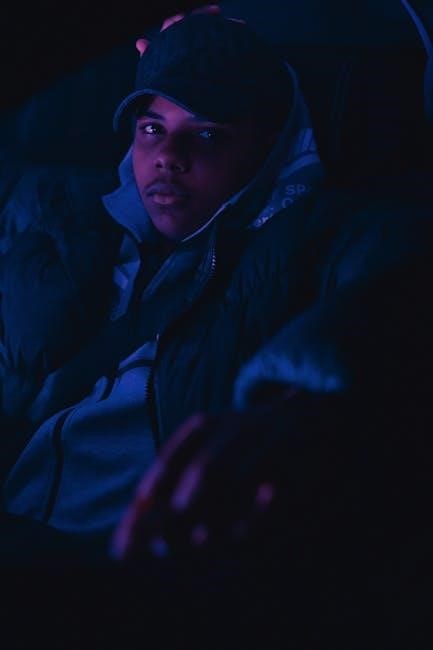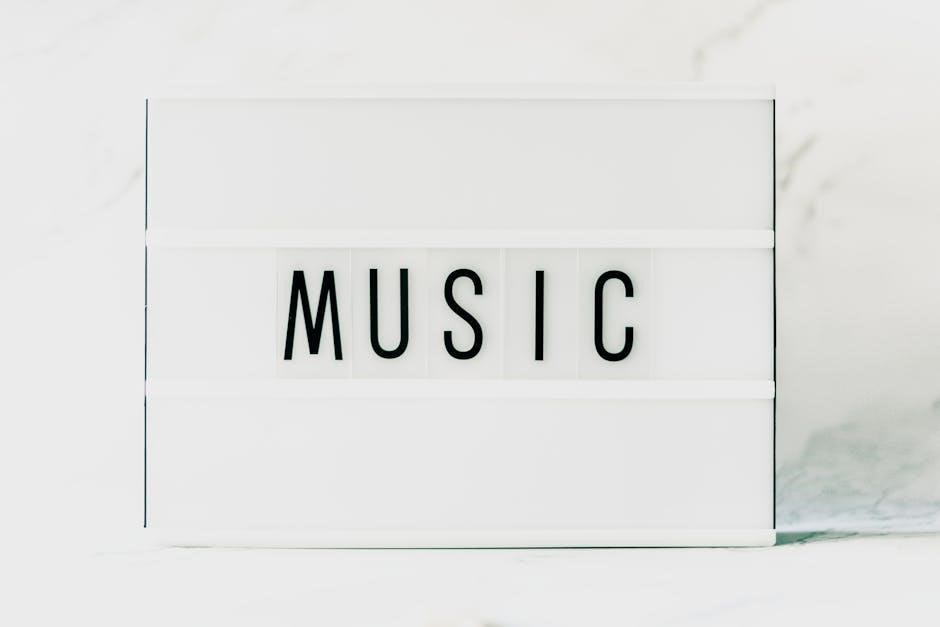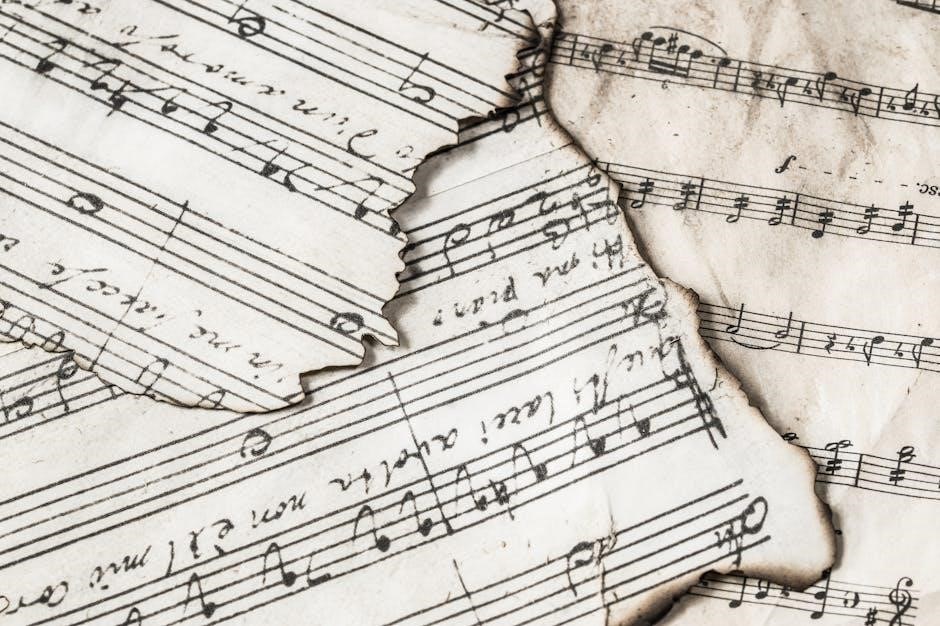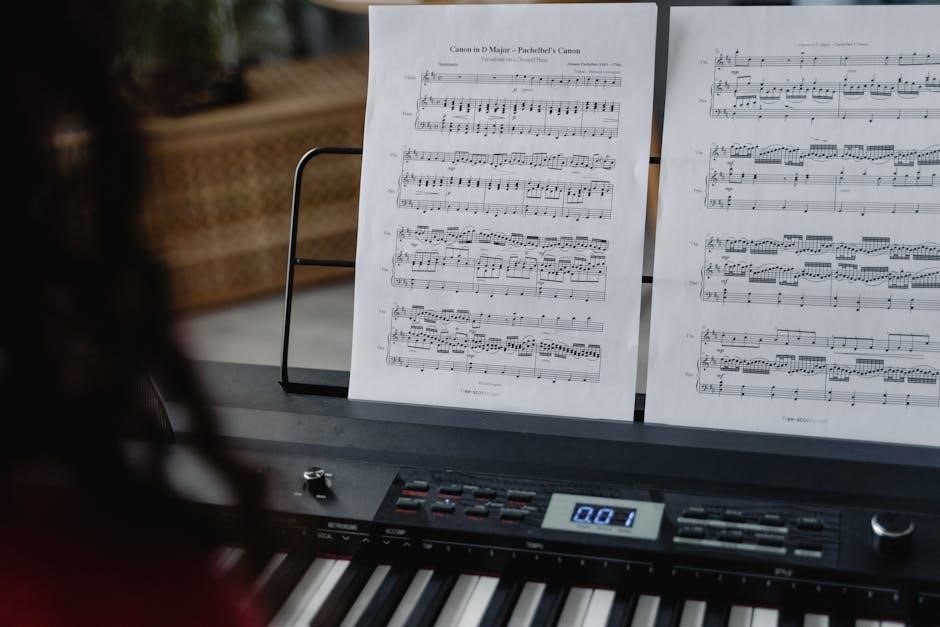Johann Pachelbel‚ a renowned German Baroque composer and organist‚ is celebrated for his iconic Canon in D‚ a piece widely used in weddings and popular culture.
Who Was Johann Pachelbel?
Johann Pachelbel was a German Baroque composer and organist‚ baptized in Nuremberg in 1653. He is best known for his iconic Canon in D‚ a piece that has become synonymous with weddings and popular culture. Pachelbel was a prolific composer‚ writing numerous cantatas‚ hymn settings‚ and chamber music‚ particularly for the violin. His works reflect the stylistic transition from the early to the late Baroque period. Although his fame today rests largely on the Canon in D‚ Pachelbel was a respected composer in his time‚ influencing later musicians‚ including Johann Sebastian Bach. His contributions to sacred music and instrumental composition remain significant‚ showcasing his mastery of counterpoint and harmonic innovation.

The Composition and Structure of Canon in D
Johann Pachelbel’s Canon in D is a Baroque composition originally written for three violins and basso continuo‚ paired with a gigue. The piece is renowned for its iconic chord progression‚ which has been widely used in popular music. Structurally‚ it follows a ground bass pattern‚ where a bass line is repeated and varied over a harmonic framework. The canon itself is built on a repeating eight-measure bass line‚ with each violin entering in succession‚ creating a layered‚ imitative texture. The key signature is D major‚ and the time signature is common time (4/4). The sheet music‚ available in formats like PDF and MIDI‚ often includes arrangements for piano‚ guitar‚ and strings‚ making it accessible to various instrumentalists. Its simplicity and beauty have made it a favorite for weddings and classical performances alike‚ while its structure has inspired countless adaptations and transcriptions.
Historical Background of the Piece
Johann Pachelbel’s Canon in D was composed during the Baroque era‚ likely in the late 17th century. Originally scored for three violins and basso continuo‚ it was paired with a gigue and intended for chamber music performances. Pachelbel‚ a prominent organist and composer‚ wrote extensively for the Lutheran church‚ creating cantatas‚ hymn settings‚ and instrumental works. His Canon in D was part of a collection of works for strings‚ reflecting the musical tastes of the time. Despite its modern fame‚ the piece was relatively obscure until its rediscovery in the 20th century. Its popularity soared as it became a staple at weddings and in popular culture‚ with its chord progression inspiring countless adaptations. Today‚ it remains one of the most recognizable and enduring pieces of Baroque music‚ with sheet music widely available in formats like PDF and MIDI for various instruments.

Sheet Music and Arrangements of Pachelbel’s Canon in D
Pachelbel’s Canon in D is widely available as free PDF sheet music for piano‚ guitar‚ and strings‚ with arrangements for solo or ensemble performances‚ ensuring accessibility for all musicians.
Availability of Free Sheet Music PDFs
Free sheet music PDFs of Pachelbel’s Canon in D are widely available online‚ offering convenient access for musicians. Websites like 8notes.com‚ IMSLP‚ and MuseScore provide high-quality downloads in various formats‚ including PDF‚ MIDI‚ and MP3. These resources cater to both solo performers and ensembles‚ with arrangements for piano‚ guitar‚ strings‚ and more. Many versions are specifically tailored for beginners‚ featuring simplified notation‚ while others offer advanced arrangements with intricate details; Additionally‚ platforms like Rakuten Kobo and Sheet Music Plus host a variety of transcriptions‚ ensuring that musicians can find the perfect arrangement to suit their skill level and instrumentation. This accessibility has made Canon in D a staple in many repertoires‚ from wedding performances to educational exercises.
Instrumental Arrangements for Piano‚ Guitar‚ and Strings
Pachelbel’s Canon in D is available in diverse instrumental arrangements‚ catering to various skill levels and preferences. Piano arrangements‚ such as those by Lee Galloway and Lemontart‚ offer both simplified and advanced versions‚ making the piece accessible to beginners and seasoned pianists alike. Guitar transcriptions‚ including classical and acoustic adaptations‚ provide a unique interpretation of the canon. String arrangements‚ often featuring violins and cellos‚ remain faithful to the original composition while emphasizing harmonic richness. These arrangements are widely popular for weddings‚ educational purposes‚ and personal enjoyment. Many versions include chord progressions and fingerings‚ aiding musicians in mastering the piece. The versatility of Canon in D ensures its enduring appeal across different instruments and musical settings.
Wedding Music and Its Popularity
Pachelbel’s Canon in D has become a timeless favorite in wedding ceremonies worldwide. Its serene and elegant structure‚ featuring a repeating bass line and harmonious counterpoint‚ creates a romantic atmosphere ideal for processions and celebrations. The piece is often performed by string ensembles‚ pianists‚ or organists‚ making it versatile for various wedding settings. Its popularity stems from its emotional depth and universal appeal‚ transcending cultural boundaries. Despite modern trends‚ Canon in D remains a staple in wedding music‚ symbolizing joy and unity. Its widespread use has led to numerous arrangements‚ ensuring its relevance across generations. The availability of free sheet music PDFs and instrumental adaptations further contributes to its enduring popularity‚ making it a cherished choice for couples and musicians alike.

Cultural Impact and Legacy
Pachelbel’s Canon in D has profoundly influenced modern music‚ inspiring countless adaptations and arrangements. Its timeless appeal spans weddings‚ films‚ and popular culture‚ cementing its legacy as a universal classic.
Use in Weddings and Popular Culture
Pachelbel’s Canon in D has become a staple at weddings worldwide‚ symbolizing elegance and joy. Its serene melody and harmonic structure make it a popular choice for ceremonies and receptions. Beyond weddings‚ the piece has been widely featured in films‚ commercials‚ and television shows‚ further cementing its cultural significance. It has also been adapted into various modern arrangements‚ from piano solos to rock covers‚ showcasing its versatility. The canon’s familiarity and emotional resonance have made it a favorite in popular culture‚ with versions by artists like George Winston and Jarrod Radnich gaining widespread acclaim. Its enduring appeal lies in its ability to evoke timeless beauty‚ making it a cherished piece across generations and genres.
Famous Arrangements and Transcriptions
Pachelbel’s Canon in D has inspired countless arrangements across various instruments and genres. Notable transcriptions include piano solos by Lee Galloway and George Winston‚ whose interpretations have become iconic. Guitar arrangements‚ such as those by Per-Olov Kindgren‚ offer a fresh acoustic perspective. The piece has also been adapted for string quartets‚ harpsichord‚ and even modern ensembles‚ blending Baroque elegance with contemporary styles. These transcriptions highlight the canon’s versatility‚ allowing it to resonate with diverse audiences. Additionally‚ arrangements by artists like Jarrod Radnich and Ben Dunnett have introduced the piece to new listeners‚ ensuring its enduring relevance in music culture. Each adaptation the original’s timeless beauty while infusing it with unique artistic flair‚ making Canon in D a masterpiece that transcends traditional boundaries.
Influence on Modern Music
Pachelbel’s Canon in D has profoundly influenced modern music‚ with its iconic chord progression appearing in numerous pop and rock songs. Artists like Green Day‚ Fleetwood Mac‚ and others have incorporated elements of the canon into their compositions. The piece’s harmonic structure‚ particularly its repetitive and resolving chord sequence‚ has become a blueprint for many contemporary tracks. Its versatility has led to adaptations in electronic music‚ hip-hop‚ and even film soundtracks. Despite criticism for its overuse‚ the canon’s timeless appeal continues to inspire musicians across genres. Its influence is a testament to the enduring legacy of Baroque music in shaping modern musical styles. The canon’s adaptability ensures its relevance‚ making it a bridge between classical and contemporary artistry. Its impact remains undeniable‚ solidifying its place in music history.

Performance and Practice Tips

Use specialized microphones for faithful sound reproduction in recordings. Practice slowly‚ focusing on dynamics and articulation. Capture every nuance to reveal the piece’s richness and balance effectively.
Tips for Beginners Learning the Piece
Beginners should start by practicing Canon in D at a slow tempo to build confidence and accuracy. Use free PDF sheet music from reliable sources like IMSLP or Musicnotes to ensure clarity. Focus on understanding the key signature‚ as D major includes two sharps (F# and C#). Practice each section separately‚ gradually increasing speed. Pay attention to dynamics and articulation to maintain the piece’s elegance. For piano learners‚ start with simplified arrangements before tackling advanced versions. Utilize online tutorials or video guides for guidance. Emphasize steady practice‚ even for short durations‚ to master the piece effectively. These strategies will help beginners enjoy learning and performing Pachelbel’s timeless composition.
Advanced Techniques for Experienced Musicians
Experienced musicians can elevate their performance of Canon in D by exploring intricate arrangements and nuanced interpretations. Experiment with dynamic contrasts‚ emphasizing crescendos and decrescendos to add depth. Incorporate ornaments such as trills and mordents to enhance the Baroque character. For pianists‚ advanced techniques like arpeggio patterns or complex fingerings can add sophistication. Consider exploring transcriptions‚ such as George Winston’s arrangement‚ for inspiration. Guitarists can experiment with fingerstyle techniques to mimic the original string texture. Advanced players may also explore tempo rubato to create a more expressive rendition. Utilize pedal techniques on the piano to sustain and blend notes seamlessly. These advanced approaches allow musicians to showcase their skill while preserving the timeless beauty of Pachelbel’s composition.
Notation and Key Signature Considerations
Pachelbel’s Canon in D is written in the key of D major‚ featuring a key signature with two sharps (F# and C#). Musicians should pay attention to natural signs‚ which may appear to override the key signature’s sharps. The composition is typically notated in 4/4 time‚ with a steady‚ flowing rhythm. The original score for three violins and basso continuo is often adapted for various instruments‚ including piano‚ guitar‚ and strings. When interpreting the sheet music‚ pianists should note the use of arpeggiated chords and legato playing to mimic the original string texture. Guitarists may need to adjust fingerings to accommodate the piece’s baroque phrasing. Ensuring accurate notation and key signature adherence is crucial for a faithful performance. PDF arrangements often include clear markings for dynamics‚ articulation‚ and tempo‚ aiding musicians in achieving an authentic rendition.
Resources and Downloads
Free PDF sheet music for Pachelbel’s Canon in D is widely available online‚ with arrangements for piano‚ guitar‚ and strings. Popular platforms like IMSLP and Musicnotes offer high-quality downloads‚ including MIDI and MP3 files‚ making it accessible for musicians of all levels to practice and perform this beloved piece.
Free Sheet Music Resources Online
Several websites offer free PDF sheet music for Pachelbel’s Canon in D‚ making it easily accessible for musicians. Platforms like IMSLP and Musicnotes provide high-quality downloads‚ including arrangements for piano‚ guitar‚ and strings. These resources often include MIDI and MP3 files‚ allowing for both practice and performance. Websites such as 8notes and SheetMusicPlus also offer free versions‚ catering to various skill levels. Many arrangements are available in multiple formats‚ ensuring compatibility with different software and devices. Additionally‚ some sites feature transpositions and adaptations‚ enabling musicians to customize the piece to their needs. These free resources have made Pachelbel’s Canon in D a staple for educators‚ students‚ and performers worldwide‚ ensuring its enduring popularity and accessibility.
Commercial Sheet Music Options
For those seeking high-quality‚ professional arrangements‚ commercial sheet music options for Pachelbel’s Canon in D are widely available. Websites like Musicnotes and SheetMusicPlus offer premium PDF downloads‚ featuring detailed notation and performance notes. These versions often include MIDI files‚ practice videos‚ and transposition options‚ catering to both amateur and advanced musicians. Commercial sheet music frequently includes fingerings‚ dynamics‚ and tempo markings‚ enhancing the learning and performance experience. Additionally‚ platforms like Hoffman Academy provide intermediate-level arrangements‚ while Jarrod Radnich offers advanced versions with intricate details. Purchasing from these sites ensures access to legally licensed and expertly curated sheet music‚ supporting both educational and professional use. These resources are ideal for musicians seeking precise and polished versions of Pachelbel’s timeless composition.

Transpositions and Adaptations
Pachelbel’s Canon in D is available in various transpositions and adaptations‚ catering to diverse instrumental ensembles and performance needs. Many arrangements offer transpositions in different keys‚ such as C major or G major‚ to suit specific instruments or vocal ranges. These adaptations maintain the piece’s iconic structure while providing flexibility for musicians. For instance‚ piano and guitar versions are popular among solo performers‚ while string quartets and orchestral arrangements are favored for ensemble settings. Some transpositions also include additional harmonies or embellishments‚ enhancing the piece’s emotional depth. Websites like Musicnotes and SheetMusicPlus provide a wide range of transposed sheet music‚ ensuring that musicians across skill levels and instrument types can enjoy performing this timeless composition. These adaptations highlight the versatility of Pachelbel’s masterpiece‚ making it accessible to a broad audience.

Educational and Historical Insights
Pachelbel’s Canon in D is a cornerstone of music education‚ illustrating Baroque counterpoint and harmony. Its historical roots in the Lutheran church and enduring popularity make it a vital part of musical heritage.

Educational Resources for Learning
Educational resources for Pachelbel’s Canon in D are abundant‚ offering learners diverse ways to engage with the piece. Free PDF sheet music is widely available online‚ providing access to the composition for various instruments‚ including piano‚ guitar‚ and strings. Platforms like IMSLP and Musicnotes offer high-quality scores‚ while websites such as 8notes and Piano Nanny cater to pianists with simplified arrangements. Video tutorials and practice guides on YouTube and specialized music blogs further assist learners in mastering the piece. Additionally‚ many educators provide annotated scores‚ highlighting key musical elements like counterpoint and harmony. These resources make Canon in D accessible to musicians of all skill levels‚ fostering both appreciation and technical growth. The availability of transpositions and adaptations ensures that learners can explore the piece in their preferred key or instrument‚ enhancing their educational journey.
Comparisons with Other Baroque Composers
Johann Pachelbel’s Canon in D stands alongside works by Bach‚ Handel‚ and Vivaldi as a quintessential Baroque composition. While Bach’s fugues and Vivaldi’s concertos showcase complexity‚ Pachelbel’s Canon is celebrated for its simplicity and timeless appeal. Its chord progression‚ now a staple in popular music‚ reflects the Baroque era’s harmonic richness. Unlike Handel’s grand operas or Bach’s intricate counterpoint‚ Pachelbel’s Canon is accessible‚ making it a favorite for weddings and modern arrangements. The piece’s enduring popularity highlights its unique balance of structure and beauty‚ setting it apart from other Baroque works. This accessibility has allowed Canon in D to transcend its historical context‚ resonating with audiences in ways that few other Baroque compositions achieve. Its influence is evident in both classical and contemporary music‚ solidifying its legacy alongside the era’s greatest composers.
The Legacy of Pachelbel’s Canon in D
Johann Pachelbel’s Canon in D has left an indelible mark on music history‚ transcending its Baroque origins to become a timeless classic. Its elegant chord progression and harmonious structure have inspired countless adaptations‚ from weddings to modern pop music. The piece’s simplicity and emotional depth make it universally appealing‚ ensuring its relevance across generations. As a staple in classical music‚ it has influenced composers and musicians‚ with its iconic melody appearing in various arrangements for piano‚ guitar‚ and strings. The availability of free sheet music PDFs has further cemented its accessibility‚ allowing learners and performers to explore its beauty. Beyond its cultural impact‚ Canon in D remains a cornerstone of music education‚ introducing many to Baroque music. Its enduring legacy is a testament to Pachelbel’s genius and the piece’s unparalleled resonance with audiences worldwide.

Modern Adaptations and Recordings
Pachelbel’s Canon in D has been reimagined in modern instrumental versions‚ including piano‚ guitar‚ and string arrangements‚ with artists like George Winston creating notable interpretations. Sheet music in PDF and MIDI formats‚ along with recordings in MP3‚ have made the piece accessible to contemporary audiences‚ ensuring its timeless appeal endures across generations and musical genres.
Modern Instrumental Versions
Pachelbel’s Canon in D has been reimagined in various modern instrumental versions‚ including piano‚ guitar‚ and string arrangements. Artists like George Winston and Jarrod Radnich have created notable piano interpretations‚ blending Baroque elegance with contemporary flair. Guitar adaptations‚ both classical and electric‚ offer fresh perspectives‚ while string quartets and orchestral renditions maintain the piece’s timeless beauty. These versions often incorporate new harmonies and rhythms‚ appealing to diverse audiences. Sheet music for these arrangements is widely available in PDF and MIDI formats‚ making them accessible to musicians of all levels. The piece’s versatility ensures its enduring influence‚ as it transitions seamlessly from traditional to modern settings‚ captivating listeners across generations and genres. Its adaptability has solidified its place as a cornerstone of both classical and contemporary music culture.
Recording Tips for Musicians
Recording Pachelbel’s Canon in D requires attention to detail to capture its rich‚ layered sound. Use high-quality microphones to ensure faithful sound reproduction‚ especially for piano or string performances. Maintain a steady tempo‚ as the piece relies on its iconic rhythmic structure. Experiment with dynamics to emphasize the interplay between instruments. For piano recordings‚ consider using a grand piano in a well-acousticked room to enhance resonance. When recording strings‚ balance the levels between violins and bass to preserve the harmonic depth. Use minimal reverb to keep the sound crisp and authentic. Practice extensively to achieve seamless transitions between sections. Finally‚ reference professional recordings for inspiration but aim to infuse your unique interpretation. These tips will help you create a captivating and polished rendition of this timeless piece.
The Piece’s Enduring Influence
Pachelbel’s Canon in D remains one of the most recognizable and enduring pieces of Baroque music‚ transcending time and cultural boundaries. Its timeless appeal lies in its elegant structure and harmonic richness‚ making it a staple at weddings and in popular culture. The piece has inspired countless arrangements and transcriptions for various instruments‚ from solo piano to full orchestral ensembles. Its influence extends beyond classical music‚ with elements appearing in modern pop‚ rock‚ and film soundtracks. The canon’s simplicity and emotional depth continue to captivate audiences‚ ensuring its relevance in contemporary music. Its widespread use in education and performance highlights its lasting impact on musical heritage‚ solidifying its place as a cornerstone of classical repertoire. The enduring popularity of Canon in D is a testament to Pachelbel’s genius and the universal appeal of his music.